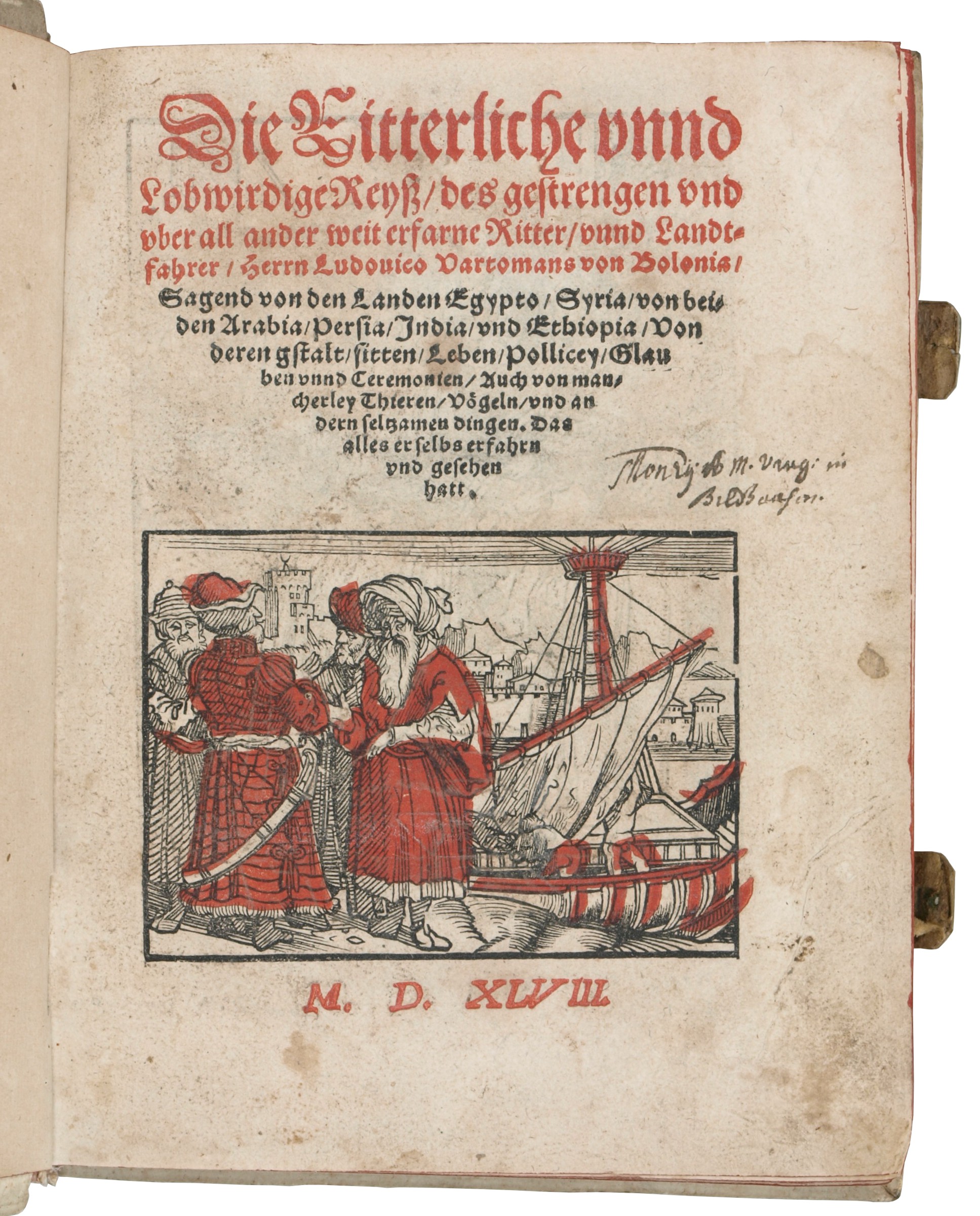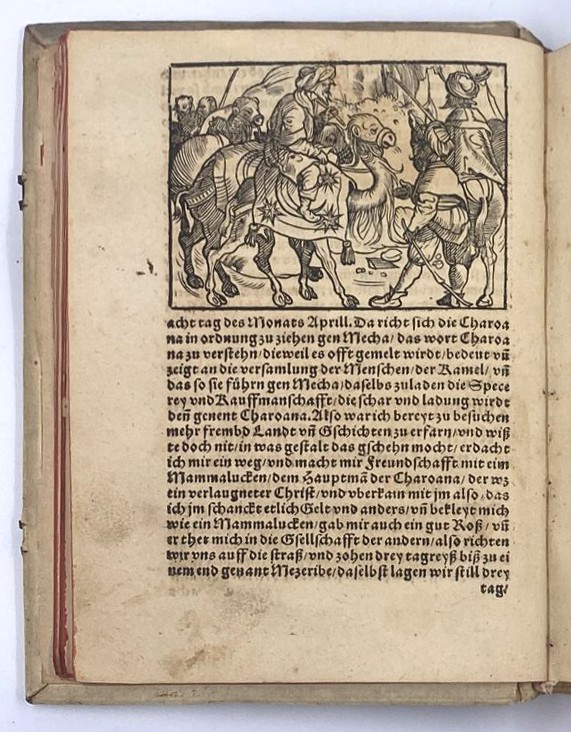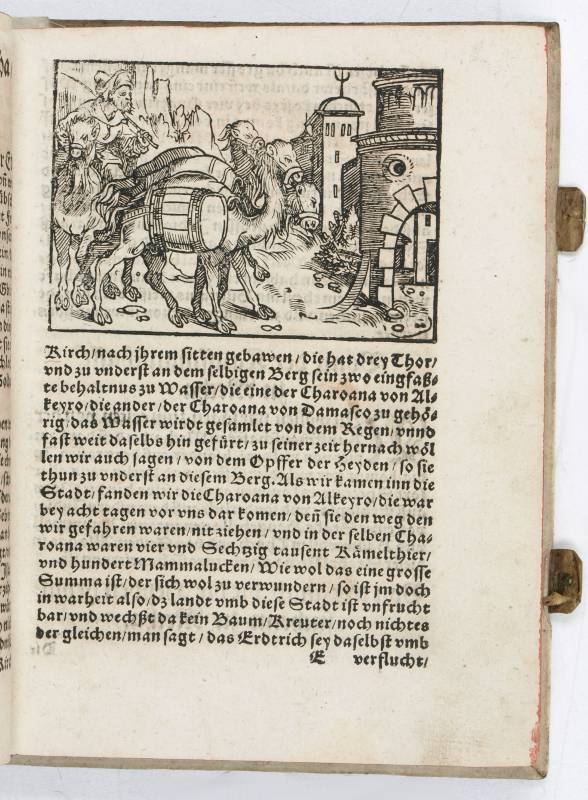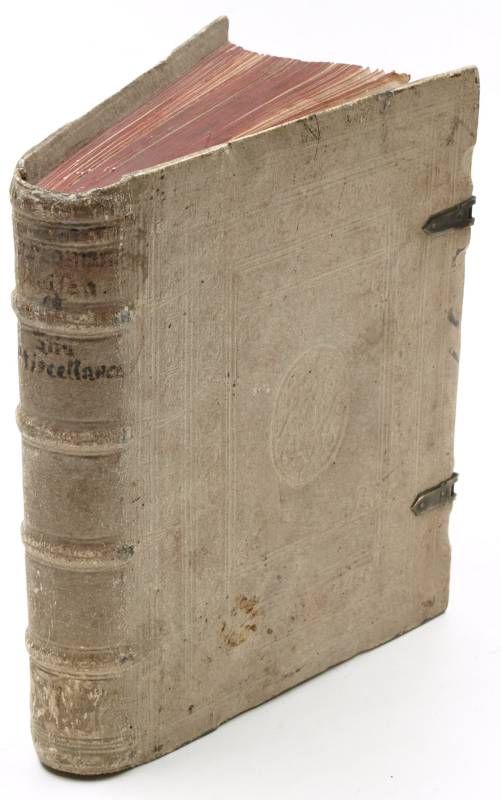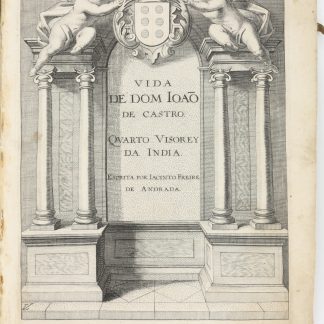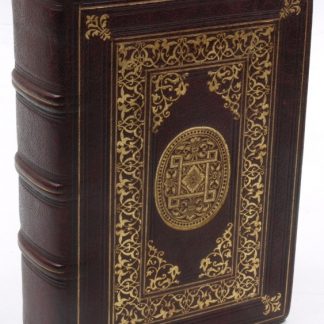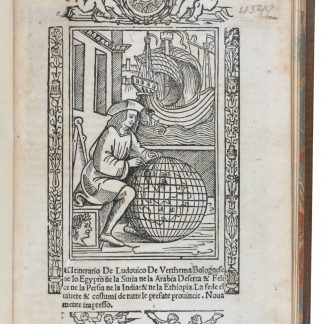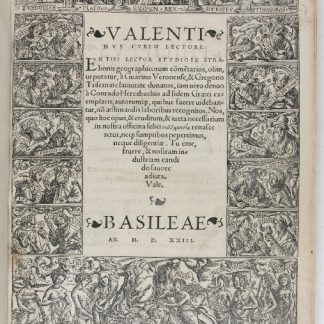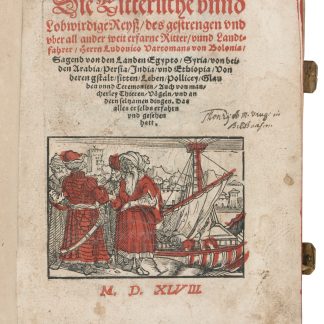The first printed eyewitness account of any place in today's UAE: an early German edition with 44 illustrations
Die Ritterliche unnd Lobwirdige Reyß [...] sagend von den Landen Egypto, Syria, von beiden Arabia, Persia, India, und Ethiopia, von deren gstalt, sitten, Leben, Pollicey, Glauben unnd Ceremonien [...].
4to. 220 unnumbered pp. Title-page and title woodcut printed in red and black; full-page woodcut on reverse of title-page and 44 woodcuts in the text by Jörg Breu the elder. Bound with eight contemporary pamphlets. Contemporary blindstamped leather over wooden boards. All edges red. Remains of two clasps.
€ 150,000.00
Sixth or seventh, still early German edition of Ludovico di Varthema's famous travels to Arabia, Persia, and India: the highly important and adventurous narrative containing the first printed eyewitness account of any place in today's United Arab Emirates. On his return journey from Mecca (which he was the first Westerner to describe), Varthema visited Ras al-Khaimah ("Giulfar") and portrayed the city as "most excellent and abounding in everything", with "a good seaport", and whose inhabitants are "all Muslims". While Montalboddo's famous anthology of discoveries, printed in 1507, contained the first printed reference to the Arabian Gulf region, it was Varthema's work, published only three years later, that offered the first actual report from the region by a Western traveller who had visited the coast. All early editions of Varthema’s account are exceedingly rare (even the 2013 Hajj exhibition at the MIA, Doha, only featured the 1655 reprint; cf. below).
Varthema, a gentleman adventurer and soldier from Bologna, left Venice at the end of 1502. In 1503 he reached Alexandria and ascended the Nile to Cairo, continuing to Beirut, Tripoli, Aleppo and Damascus, where, adopting Islam and taking the name of Yunas, he joined a Mameluke escort of a Hajj caravan and began the pilgrimage to Mecca. Varthema was amazed by what he observed: "Truly I never saw so many people collected in one spot as during the twenty days I remained there", he begins, and arriving at the Great Mosque, continues, "it would not be possible to describe the sweetness and the fragrances which are smelt within this temple." Thanks to his knowledge of Arabic and Islam, Varthema was able to appreciate the local culture of the places he visited. Impressed and fascinated, he describes not only rites and rituals, but also social, geographical, and day-to-day details. "I determined, personally, and with my own eyes", he declares in the prefatory dedication, "to ascertain the situation of places, the qualities of peoples [...] of Egypt, Syria, Arabia Deserta and Felix, Persia, India, and Ethiopia, remembering well that the testimony of one eye-witness is worth more than ten hear-says." His good fortune did not continue unabated, however: after embarking at Jidda and sailing to Aden, he was denounced as a Christian spy and imprisoned. He secured his release and proceeded on an extensive tour of southwest Arabia. Stopping in Sanaa and Zebid as well as a number of smaller cities, he describes the people, the markets and trade, the kind of fruits and animals that are plentiful in the vicinity, and any historical or cultural information he deems noteworthy. Returning to Aden, and after a brief stop in Ethiopia, he set sail for India. In addition to visiting Persia, Varthema explored the coasts of Malabar and Coromandel, including a stay at Calicut at the beginning of 1505. He also purports to have made extensive travels around the Malay peninsula and the Moluccas. Returning to Calicut in August 1505, he took employment with the Portuguese at Cochin and, in 1508, made his way back to Europe via the Cape of Good Hope.
First published in 1510, Varthema's account became an immediate bestseller. In addition to his fascinating account of Egypt, Syria, the Arabian Peninsula, and the holy Muslim cities, "Varthema brought into European literature an appreciation of the areas east of India [...] which it had previously not received from the sea-travelers and which confirmed by firsthand observations many of the statements made earlier by Marco Polo and the writers of antiquity" (Lach, I. i. 166). "Varthema was a real traveller. His reports on the social and political conditions of the various lands he visited are reliable as being gathered from personal contact with places and peoples. His account of the overland trade is of great value in that we are made to see it before it had begun to give way to the all-seas route. He even heard of a southern continent and of a region of intense cold and very short days, being the first European probably after Marco Polo to bring back the rumor of Terra Australis" (Cox I, 260).
Bound at the end of the volume are eight rare contemporary pamphlets, including two concerned with the Ottoman wars, two others so rare that they are bibliographically unrecorded (a full list with references is available upon request). Binding is mildly rubbed and bumped; interior shows slight browning and fingerstaining with occasional edge damage. Pastedown has ownership and bookplate of the Bildhausen Cistercians, dissolved in 1803.
VD 16, ZV 15159 (BSB copy lost). IA 113.553 (s. v. "Barthema", citing 212 pp. only: no more than six copies, all in Germany). Goedeke I, 379, 17, 7. Cf. Röhricht no. 574, p. 164; Cordier Indosinica I, 103; Röttinger 115 (all for Gülfferich's 1549 ed.). Cf. exhibition cat. "Hajj - The Journey Through Art" (Doha 2013), p. 90 (1655 Dutch ed. only). Blackmer 1719. Gay 140 (a 1556 Frankfurt ed). Cox I, 260. Macro 2239 (other eds.). Carter, Sea of Pearls, p. 68 (1520 ed.). Boies Penrose, p. 28-32. Not in Atabey, BM, or Adams.

